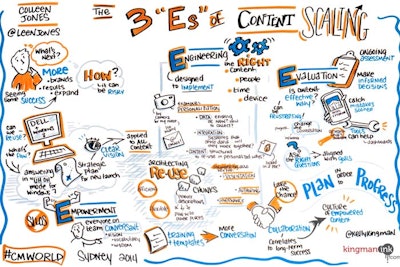
Let’s start with what content marketing is not: It’s not advertising. It’s not promotion. And it’s not a short-term strategy. Content marketing means providing a consistent stream of useful and relevant information to a target audience so they see a brand, corporate entity, or nonprofit as a credible resource on a topic. The content may come in the form of blog posts, podcasts, newsletters, webinars, workshops, or any number of other ways to share information. The ultimate goal of content marketing is to create loyal fans that will buy what the marketer is trying to sell. For planners, that product is events.
“Don’t think of yourself as an event company; think of yourself as a media platform,” says Joe Pulizzi, founder of the Content Marketing Institute. “One of the things you want them to buy is the event, but you have to keep that communication going all year long, and it can’t just be information about what you are trying to sell. Most of it should not be talking about the actual event.”
Pulizzi puts that concept into practice. His primary “products” are two annual conferences on content marketing, one in Cleveland in the fall and one in Sydney, Australia, in the spring. To help attract attendees, he established the Content Marketing Institute as a leading source on the topic. His communication tools include a daily blog post, emails to 80,000 subscribers, a weekly newsletter, a weekly podcast, webinars twice a month, master classes, Twitter chats, executive forums, online training, dozens of e-books, and a bimonthly magazine with 15,000 print subscribers and 7,000 digital.
[PULLQUOTE]
Pulizzi’s model is comprehensive, but content marketing can be done on a smaller scale. Planners should begin by identifying the target audiences for their events—for example exhibitors, sponsors, buyers—and then determining what specific content will prompt the desired behavior from those groups. “You’re not going for reach. You’re trying to reach the right people with the right message at the right time,” Pulizzi says. For meeting and event planners, this can be done by pinpointing topics that will interest and educate that specific group of people.
Once the audiences, outcomes, and topics are understood, planners need to develop an editorial calendar, similar to what a traditional media company would use, that outlines content distribution tools and schedules. Pulizzi recommends podcasts because “it’s the only platform right now where there are fewer content creators than consumers.” For his most recent conference in Sydney, he found that a third of the attendees were also subscribers to his “This Old Marketing” podcast that is available on Google Play and iTunes.
Most organizations already have a supply of appropriate content, such as presentations and articles created by staff or information shared at past events. “I spoke at 100 events last year and probably 90 percent don’t even record the sessions, which blows my mind,” Pulizzi says. “They have all kinds of content they can reimagine and repurpose, and they’re not doing it.”
Meeting and event organizers should also seek and share content from others. “We figure out where our customers are hanging out when they’re not on our site, and then we try to figure out how can we get those sites and those influencers involved in our editorial strategy,” Pulizzi says. He currently has about 200 people who contribute entries for his daily blog who also share the posts with their networks. Other sources of content include freelance writers, an event’s speakers and exhibitors, and dedicated content marketing companies such as Brandpoint, Imagination Publishing, Pulse Network, and PulsePoint.
Regardless of the source, the information provided needs to foster engagement, so it should be easy for the audience to subscribe to the content and to share it on social networks. Content marketers should also include a call to action, which might be a link to request more information or to register for the next event. Then the engagement can be tracked and the data used to cross-reference content marketing outcomes with event outcomes.



















